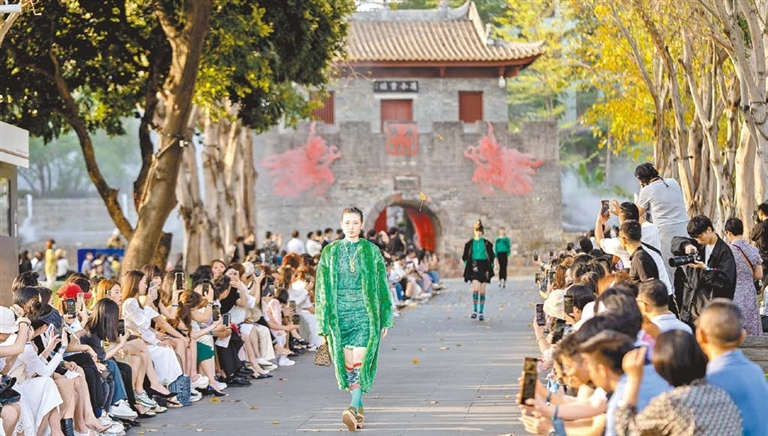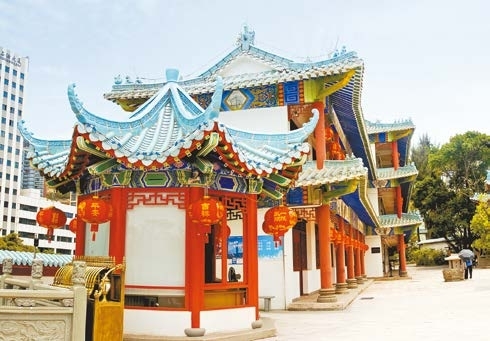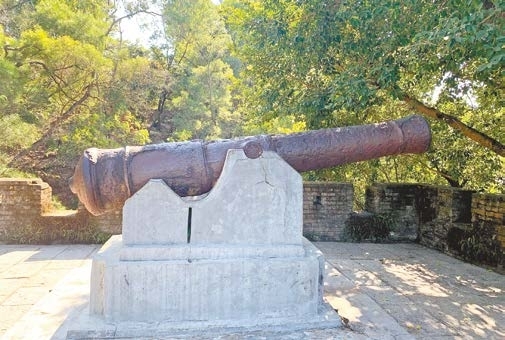


IF you are seeking a fun weekend without having to travel far, Nanshan District is truly a great destination. The district in western Shenzhen has a wave of fun places, historic and modern, natural scenery and cultural landscape, to offer. Nantou Ancient Town Also known as Xin’an Old Town, Nantou Ancient Town was once an administrative center, a significant coastal fortress and a hub of sea transportation and foreign trade. First built in 331 during the East Jin Dynasty (317-420), the historical site is acknowledged as the cultural roots of Shenzhen and Hong Kong, witnessing the changes for nearly 1,700 years. The walls on the north and south of the ancient town are well preserved, with the southern gate bearing in seal script the Chinese characters “宁南,” meaning peace in the south, on its top. A dozen historical sites in Nantou Ancient Town are worth a visit, including the Xin’an Prefecture Office. The site, refurbished as a museum and having over 300 pieces of antiques on display, opens free to the public from Tuesday to Sunday. Tianhou Temple Situated at the foot of Xiaonanshan Moutain in Chiwan, Shekou, the Tianhou Temple was built during the Song Dynasty (960-1279) to honor the Sea Goddess Mazu. The temple served as an important stop along the ancient Maritime Silk Road, the sea route used by Ming Dynasty (1368-1644) diplomat Zheng He during his naval expeditions to the West under the reign of Emperor Yonghe. Also known as the Mazu Temple, the temple is said to be the largest of its kind in South China, with the main hall of the temple having 99 doors. Various events are held at the temple throughout the year, including a celebration of Mazu’s birthday and performances for the Chinese New Year. The temple features a drum tower, a bell tower, and statues of two great generals — one with eyes that see a thousand miles away and the other with ears that hear sounds from afar — who guard the goddess. The Left Fort On top of the Yingzui Hill in Chiwan, the Left Fort was built in 1669 during the Qing Dynasty (1644-1911). Originally the Chiwan Ancient Fort with 12 iron cannons lining the left and right sides on a promontory overlooking the Lingding Sea, only the fort on the left remains intact, and hence the Left Fort. It played a critical role in centuries-old coastal defense against Portuguese, Dutch, and British invaders in the Lingding Sea from the 16th to the 19th centuries and throughout the Opium Wars (1839-1842; 1856-1860). Today, the Left Fort site features a statue of opium smuggling fighter Lin Zexu, a cannon on a sea-view platform, old barracks and stone steps. Two banyan trees already 130 years old accompany the rusty cannon. Tomb of last Southern Song emperor At the foot of the Xiaonanshan Mountain rests the last emperor of the Southern Song Dynasty Zhao Bing. A city-level protected cultural heritage in Shenzhen, this is the only royal tomb in Guangdong Province. Although an emperor’s mausoleum, a burial mound and a simple tombstone at the center inscribed with “大宋祥庆少帝之陵”(meaning “Tomb of Xiangqing Emperor of Song Dynasty”) stand as the only evidence of this being the resting place of Zhao Bing, who was in exile in Guangdong after losing his empire. On a stone tablet east of the tomb, visitors can read a brief introduction of the Song emperor, who had been accompanied in his final days by a loyal minister named Lu Xiufu. Lu drowned himself with the emperor in the sea after being defeated by Yuan (1271-1368) armies. A 4-meter-tall stone statue depicting the scene of their suicides stands west of the tomb. Shekou New Street Formerly known as Shekou Old Street, Shekou New Street is a commercial neighborhood with a rich history in Shekou Subdistrict in the southeastern part of Nantou Peninsula. Legend has it that a giant snake demon lived on the peninsula, often roaming the sea and bringing flooding disasters to the area because it was unhappy with the fishing activities of local fishermen. Tormented by these countless disasters, the locals united to confront the snake demon in a fierce battle and ultimately killed it. After its death, the head of the snake demon transformed into the shape of Shekou on the peninsula. The fishermen then established a small town in the area that gradually developed into a bustling business neighborhood with various eateries, artifact shops, coffee shops and bars. Shekou is lined with architecture primarily characterized by Lingnan style. The exquisite brick carvings and signature qilou buildings showcase a rich local cultural heritage. A wealth of folklore and traditional cultural activities, such as the Kaiding Festival in Yu’er Village, which celebrates births on the 13th day of the first lunar month, has been passed down through generations here, providing visitors with a unique experience of local culture.(Wei Jie) | 
